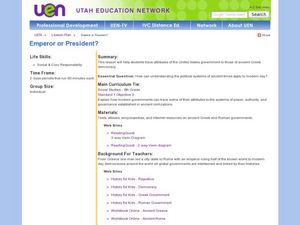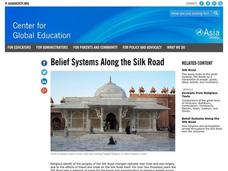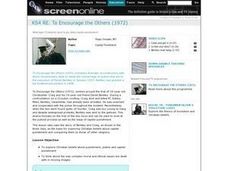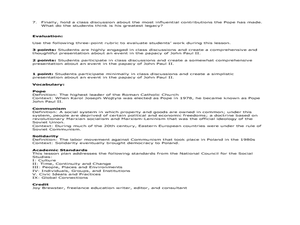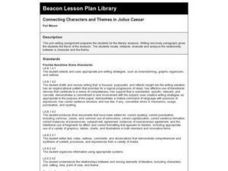Curated OER
Emperor or President?
Sixth graders complete a Venn Diagram. In this government comparison instructional activity, 6th graders discuss how rules are similar and different at home, school and in their community. Students learn about the type and structure of...
Curated OER
Mythology and Ancient Civilizations
Third graders examine ancient world civilizations and the mythologies they created to explain natural phenomena, as well as the writers and poets who wrote about the mythologies.
Curated OER
Using the Stock System
In this compounds learning exercise, students learn the rules for naming compounds, the stock system. Students apply these rules by writing the names or formulas for the 20 given compounds.
Curated OER
Egyptian Hireroglyphs
Fifth graders identify the aspects of Ancient Egyptians and Heiroglyphs. They compare and contrast Egyptian Hieroglyphs with the decimal number system. Students recognize the decimal number system and compares to bases other than ten.
Curated OER
Paper or Plastic: Exploring Renewable Resources.
Students discuss, develop, invent, and implement a plan for making informed personal economic decisions about renewable resources.
Curated OER
Religion in Japan Japanese Writing
Study the three writing systems of Japanese: Hiragana, Katakana and Kanji. Your middle schoolers will practice writing Kanji and write a mini story in English which uses at least 10 of the Kanji in the place of the English words....
Curated OER
Making Sense of the Reformation in 1 Day
Ninth graders explore the events of the Protestant Reformation. in this religious denominations lesson, 9th graders use the provided graphic organizer to take notes on a PowerPoint presentation about the different beliefs withing...
DiscoverE
Marble Run
It's time to slow your roll! Can your class create a track that allows a marble to roll as slowly as possible? Teams of science scholars collaborate to design, build, and test their tubes while learning about gravity and friction.
Curated OER
Written Response: Jewish immigration to Palestine
Examine Jewish and Arab sovereignty as it relates to the control of Palestine. Pupils read a passage explaining the history of the conflict, then write a 10-sentence paragraph describing what they would do if they were a member of the...
Curated OER
Belief Systems Along the Silk Roads
Students reflect on similarities and differences among belief systems. Using excerpts of translated religious texts, they organize these quotations into broad themes. The quotations will be posted on a Silk Roads map as reminders of how...
Curated OER
Building Aqueducts
Students simulate building a Roman aqueduct using an interactive website. In this social studies instructional activity, students design their own class aqueduct. They construct one inside the science classroom.
Curated OER
Star Quest
Learners engage in a instructional activity of using maps in order to find constellations in the night sky. They also conduct research using three constellations. The research is used to create a project to inform others. The teacher...
Curated OER
Does the falling tree make a sound if no one if there to hear it? (or communication via encryption)
Students explore encryption. They discuss the importance of cryptography in our daily lives. Students use games and cryptography to discover transformational geometry and modulo systems. They design their own encryption puzzles and...
Curated OER
To Encourage the Others (1972)
Students explore, examine and study Christian beliefs about punishment, justice and capital punishment. They view and analyze the way complex moral and ethical issues are dealt with in moving images like the screen/movie. Each student...
Curated OER
Duke Ellington and His Orchestra, Dance of the Floreadores, Waltz of the Flowers in the Meter of Duke
Students contrast the meter and style of two different versions of the musical piece, "Waltz of the Flowers." Duke Ellington's meter in the "Dance of the Floreadores" is compared to Tchaikovsky's version in the "Nutcracker."
Curated OER
Pope John Paul II
Students discover the accomplishments of Pope John Paul II. In this world history lesson, students research selected websites about the history of Poland, the accomplishments of Pope John Paul II, and...
Curated OER
Population Diversity in Southeast Asia
Students explore diversity in ethnic, lingual, religious, and political systems of the people of Southeast Asia. The activity's focus is designed to foster an understanding of the complexity of the region.
Judicial Branch of California
Defining Civic Duty and Participation
A lesson, geared toward older elementary scholars, combines art with social studies to explain the purpose of civic duty and how to encourage others in the community to participate. Academics create advertising campaigns to promote civic...
Curated OER
Early Central Heating
In this history of heating worksheet, students read about the different ways of heating rooms over time. They answer three critical thinking questions about conduction, convection and heating.
Curated OER
Greek Gods Who Are They?
Sixth graders research a Greek God with a partner and prepare a presentation for the class. They use the computer and Internet, as a motivator for a Social Studies unit and explore the mythology, legends, values and beliefs of a people.
Curated OER
Maya Math: Addition and Subtraction
Learners examine how ancient Maya counted, and practice addition and subtraction using Maya number glyphs.
Curated OER
Pope John Paul II: Triumph Over Communism
Young scholars discover the background of Pope John Paul II. In this modern history lesson, students research the life of Karol Joseph Wojtyla (Pope John Paul II) in order to understand how his past paralleled his papacy.
Curated OER
Connecting Characters and Themes in Julius Caesar
Fourth graders prepare for the literary analysis. They locate, interpret, evaluate and analyze the relationship between a character and the theme. After a lecture/demo, 4th graders write topic and detail sentences, then correctly put...
Smithsonian Institution
Dia de los Muertos: Celebrating and Remembering
Help scholars understand the history, geography, traditions, and art of Dia de los Muertos, the Day of the Dead. Find background information for your reference as well as a detailed cross-curricular lesson plan. Learners compare...
